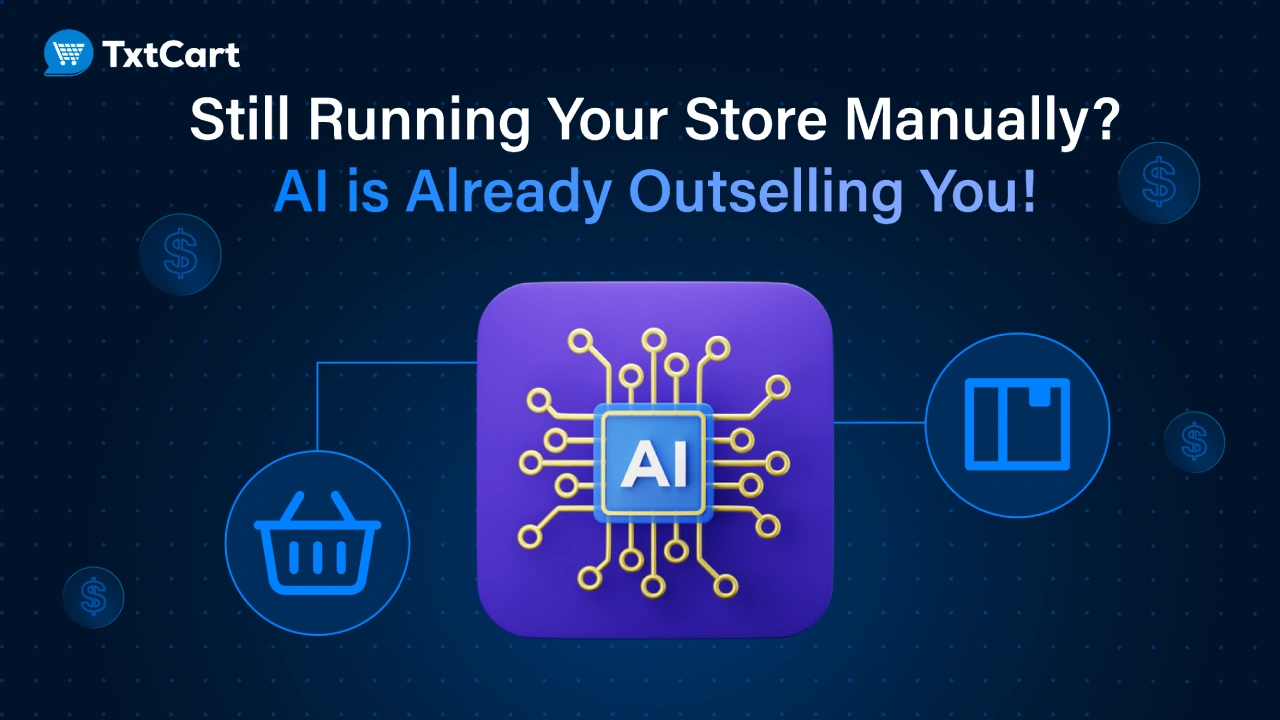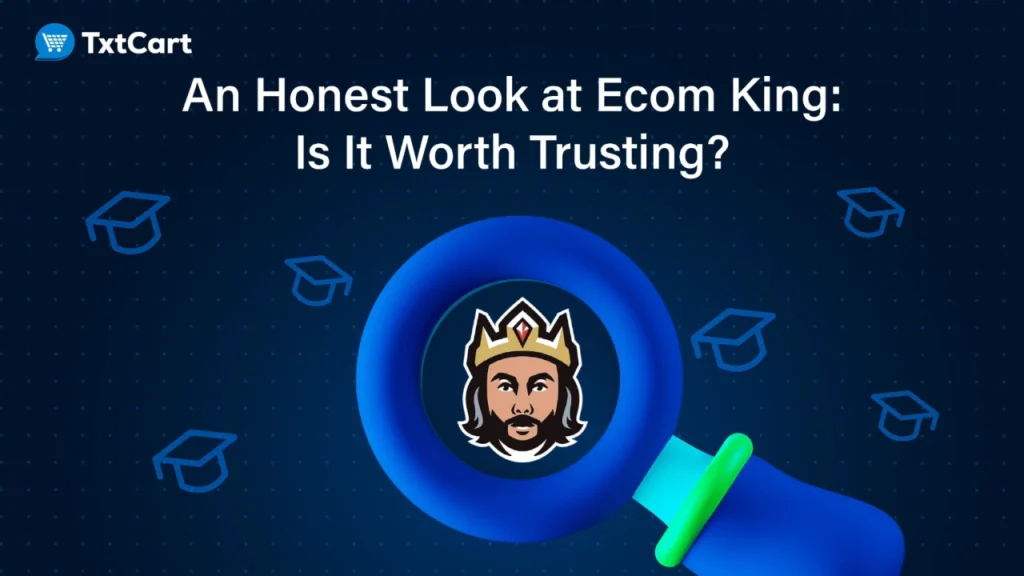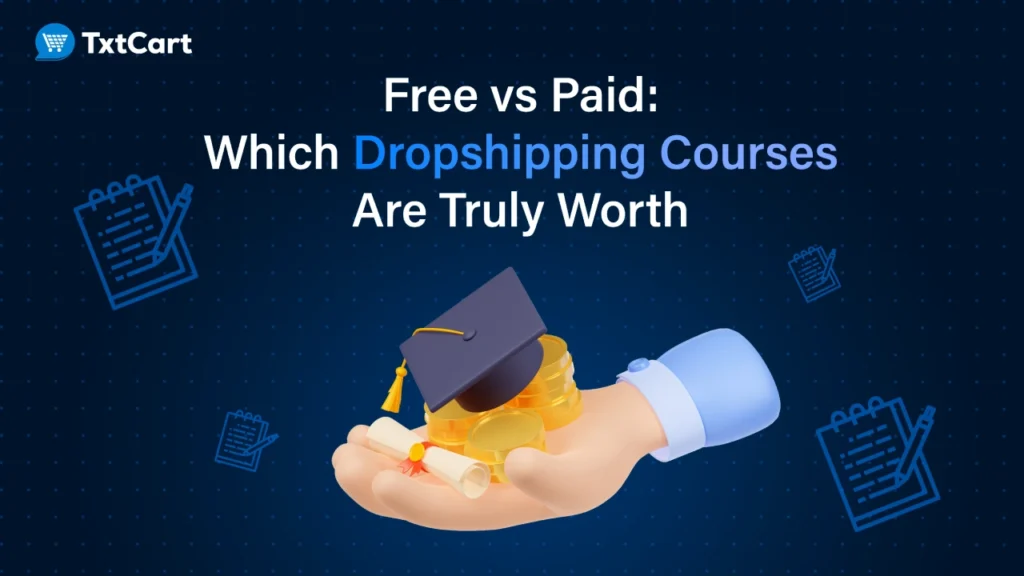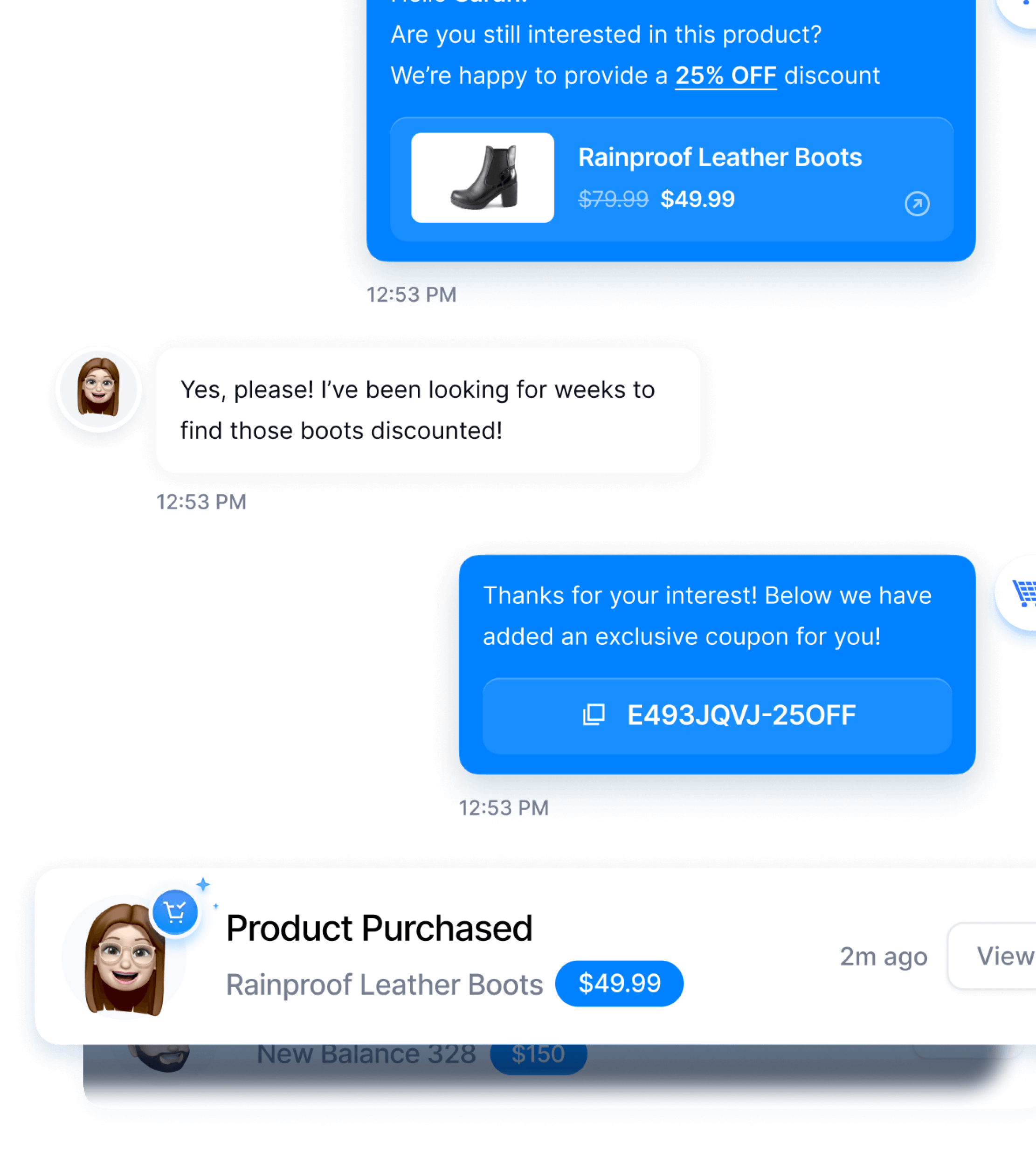The dropshipping industry is booming, projected to reach over $537.8 billion by 2026. Just when you master one strategy, a new wave hits. Artificial intelligence is that wave, promising effortless automation and smarter decisions. But knowing AI exists isn’t enough; you need to understand how to truly use it to transform your business.
Here’s what we’ll cover:
- Discover how AI streamlines everything from product finds to customer chats.
- Learn practical ways AI boosts efficiency, profits, and customer satisfaction.
- Explore key AI tools and a step-by-step guide for implementation.
P.S., we tested all of this using TxtCart, so if you want to skip the guesswork and see AI in action for abandoned carts and customer engagement, keep an eye out for our notes.
Ready? Let’s go!
TL;DR: How to Use AI for Dropshipping
Here’s a quick summary of how AI can transform your dropshipping business:
| Area of Dropshipping | How AI Helps (Key Benefit) | Key AI Function/Features Mentioned |
|---|---|---|
| Product Research | Find winning products faster based on data, spot trends early. | Trend analysis, competitor monitoring, sales velocity tracking, product validation (e.g., Sell The Trend, Peeksta, Minea). |
| Marketing & Advertising | Create compelling, targeted campaigns that boost sales. | AI content generation (copy, descriptions – e.g., Rytr, Hypotenuse), precise audience segmentation, ad campaign optimization. (TxtCart AI copy assistant for SMS) |
| Pricing Optimization | Set dynamic prices to maximize profit and stay competitive. | Dynamic pricing (competitor monitoring), price elasticity analysis, psychological pricing (e.g., Sniffie, Prisync). |
| Virtual Inventory | Accurately forecast demand and manage supplier stock flow. | Demand forecasting, real-time stock monitoring, streamlined order processing (e.g., Netstock, Oracle NetSuite, Logiwa WMS). |
| Customer Service | Provide fast, personalized support and improve satisfaction. | AI Chatbots (FAQs, guidance – e.g., Tidio), personalized recommendations (e.g., Bloomreach), feedback analysis. (TxtCart conversational SMS for inquiries & recovery) |
| Implementation | Integrate AI successfully without getting overwhelmed. | Assess needs, start small, integrate with platforms like Shopify (TxtCart offers seamless Shopify integration), train & optimize. |
Why Use AI in Your Dropshipping Business?
Trying to run a dropshipping business manually in today’s competitive market is like trying to paddle a canoe against a speedboat. AI gives you the engine you need. The benefits aren’t just theoretical; they translate directly into saved time and increased revenue for your online store.
Automation leads to significant cost reductions: AI algorithms have been shown to reduce operational costs by 40% to 60% and decrease call times by 60% to 70% in customer service contexts.
Let’s break down the core advantages:
- Serious Time Savings & Operational Efficiency: AI automates repetitive, time-consuming tasks that used to chain you to your desk. We’re talking about tasks like processing orders, keeping track of virtual inventory levels, and answering common customer questions. Think of the hours freed up!
- Data-Driven Decision Making: Your gut feeling is great, but data is better. AI analyzes customer data, market trends, and competitor prices to give you solid insights. This means you pick winning products based on real demand, set competitive pricing strategies, and target your marketing efforts precisely.
- Enhanced Customer Experience: Happy customers come back. AI helps you provide 24/7 support with smart chatbots and delivers personalized shopping experiences. It can even suggest products based on past behavior, making customers feel seen and valued.
- Increased Profitability: By cutting down operational costs through automation, minimizing costly errors like overselling, and optimizing everything from pricing to marketing campaigns, AI directly boosts your bottom line. You make more money with less manual work.
AI for Product Research and Selection
Finding products that sell is the lifeblood of a profitable dropshipping business. AI transforms this crucial step from guesswork into a targeted, data-backed process. You’re not just hoping a product hits; you’re making an informed decision based on what the market is telling you.
Finding Market Trends with AI
AI tools comb through enormous amounts of online data – everything from search engines to social media chatter and marketplace sales. They can spot emerging market trends before they explode, giving you a crucial first-mover advantage.
These tools track key indicators:
- Search volume: Are people actively looking for this? How is search volume changing over time?
- Social buzz: What are people talking about on platforms like TikTok, Instagram, and Facebook? Are products getting significant engagement?
- Sales velocity: How quickly are similar products selling on major marketplaces?
- Seasonal shifts: Are there predictable peaks and valleys in demand throughout the year?
Tool Spotlight – Sell The Trend: This tool uses AI to sift through millions of products and stores daily. It identifies trending items based on real-time data like sales volume increases and social media engagement. Sell The Trend’s feature, for example, shows you products the AI predicts are about to go viral, complete with supplier info and engagement stats.
Analyzing the Competition Effortlessly
Manually checking competitor stores is tedious and slow. AI automates competitor analysis, providing insights into what’s working for others.
AI can monitor:
- Competitor’s best-selling products
- Their pricing strategies and ongoing promotions
- Customer reviews and sentiment (identifying product pages that frustrate customers or delight them)
- How they’re optimizing their product pages
Use Peeksta: Peeksta focuses heavily on competitor tracking. You can monitor specific stores and products to see their estimated sales, ad creatives they’re running, and even traffic sources. Its AI helps you dissect competitor strategies to understand what’s driving their success without spending hours doing it manually.
AI-Powered Product Validation Framework
Use AI to put potential products through a rigorous validation process. This isn’t just about spotting a trend; it’s about ensuring the product makes business sense.
| Criteria | AI Tool Function | What to Look For | How AI Helps |
|---|---|---|---|
| Market Demand | Trend Analysis | Steady or growing search volume and social interest | Identifies search trends and social media engagement metrics. |
| Competition | Competitor Scanning | Moderate competition (saturated markets are tough) | Monitors competitor stores and identifies top sellers in your niche. |
| Profit Margin | Price Analysis | Aim for 30%+ after all costs | Analyzes competitor pricing and potential costs from dropshipping suppliers. |
| Problem-Solving | Review Analysis | Products that solve clear problems for customers | Summarizes customer reviews to highlight common pain points or benefits. |
| Marketing Potential | Ad Creative Analysis | Visual appeal and storytelling opportunities | Analyzes successful ad creative for similar products. |
P.S., we’ve seen how crucial finding winning products is. What’s equally vital? Ensuring customers complete checkout. TxtCart’s abandoned cart recovery sequences, powered by conversational AI, engage customers in real-time, answering questions or offering small incentives to finalize their purchase. It’s a key piece of the puzzle.
Wondering if this really works? Take Organi Grow Hair, for example. They leveraged TxtCart’s conversational SMS campaigns to tackle cart abandonment and boost customer engagement. The results speak for themselves: over $1.2 million in SMS-attributed revenue, a 16.9x ROI, and a 32% increase in subscribers—all within a short time frame.
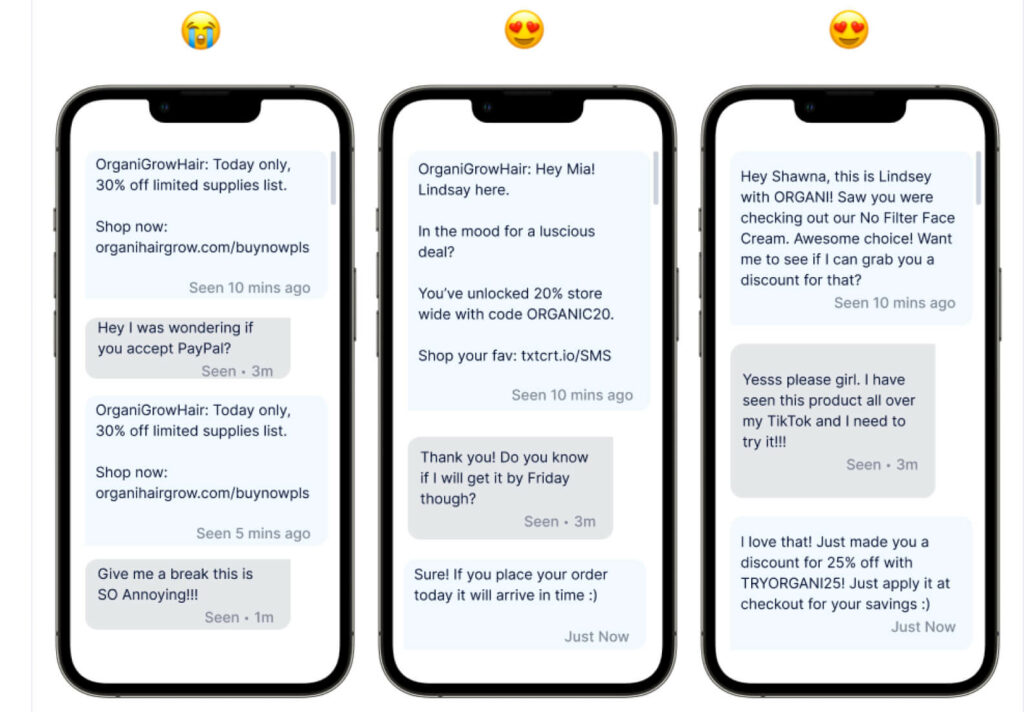
By combining real-time conversations with personalized offers, Organi achieved a 6.43% increase in sales and recovered more than 24,000 orders.
AI for Marketing and Advertising
Reaching your target audience effectively is paramount. AI transforms marketing strategies from broad strokes to laser-focused, personalized campaigns that attract customers who are ready to buy. It helps you craft compelling marketing materials that resonate.
Generating High-Quality Social Media Content (TikTok, IG, YouTube)
Writing unique product descriptions, ad copy, and marketing emails takes time and skill. AI content generation tools can produce high-quality text in minutes, ensuring consistency and freeing you up for strategy.
Using AI, you can create:
- Unique and SEO-optimized product descriptions that highlight benefits.
- Variations of ad copy tailored for different platforms and customer preferences.
- Engaging email marketing content for lead nurturing or promotional campaigns.
- Catchy social media posts are designed to drive customer engagement.
Relevant AI tools in marketing and advertising:
Here are some AI tools helping with marketing content and creative:
- Jasper: This AI writing assistant helps generate various forms of marketing copy, from product descriptions to social media updates and email subject lines. You provide a prompt, and it helps draft creative text options quickly.
- Creatify: Creating video ads for platforms like TikTok or Instagram can be complex. Creatify uses AI to quickly generate video ad variations from product links or existing assets, helping you test different creative approaches efficiently.
- Icon: Icon is another AI-powered tool primarily focused on ad creation, helping generate copy, visuals, and layouts for various ad formats. It assists in repurposing video content and can provide insights into ad performance, aiming to streamline the process of getting ads ready to run.
SMS & Email Marketing (with AI Assistants)
Writing SMS or email campaigns that don’t get ignored takes more than a discount code and a smiley face. You need the right message, at the right time, with just enough personality to spark action. AI makes this faster, smarter, and scalable.
Using AI, you can create:
- Conversational SMS flows that feel personalized, even when sent to thousands of subscribers.
- High-converting abandoned cart texts that adjust tone and offer based on customer behavior.
- Promotional emails written in seconds, optimized for subject line performance and engagement.
- Behavior-based drip sequences that trigger based on clicks, views, or past purchases.
- Dynamic product recommendations embedded into emails or texts, updated in real-time.
Relevant AI tools for SMS & Email:
- TxtCart: TxtCart is purpose-built for SMS marketing. Its AI assistant helps you send personalized abandoned cart reminders, promos, and product alerts. You get message suggestions based on audience behavior, all written in a tone that feels human.
- Our TxtCart platform features an AI assistant specifically designed for SMS marketing. It helps dropshippers quickly generate personalized, high-converting message options for abandoned carts or promotions, ensuring your texts stand out and get responses.

- Campaign Monitor: For email campaigns, Campaign Monitor uses AI to suggest subject lines, test content variations, and segment subscribers for better targeting. The result? Higher open and click-through rates without manual testing.
Precise Audience Targeting
Guessing who your ideal customer is wastes money. AI analyzes customer data and online behavior to build detailed customer segments and identify your most profitable audience.
You can improve targeting by:
- Creating detailed customer segments based on purchase history and browsing behavior.
- Identifying lookalike audiences who share characteristics with your best customers.
- Predicting customer lifetime value to optimize your ad spend on acquiring valuable customers.
- Determining the optimal times and places to show ads across various digital marketing channels.
Audience Targeting Tools
Skip the guesswork and serve content to people most likely to buy. These AI tools help you do that:
- Segment – Break your users into smart segments based on real-time behavior and attributes. Integrates well with CRMs and ad platforms.
- Optimove – Predicts which users are likely to churn, convert, or spend more. Adjust campaigns accordingly.
- Claritas – Combines online and offline data to build precise customer profiles.
- Meta’s Advantage+ Audiences – Uses machine learning to find your ideal customer across Facebook and Instagram with minimal setup.
BTW, TxtCart’s smart customer segmentation allows you to filter audiences based on actual subscriber behavior, such as purchase history, engagement levels, or even their abandoned cart status. This capability is essential for creating highly personalized SMS campaigns that resonate deeply with specific groups, driving significantly higher engagement and conversion rates.
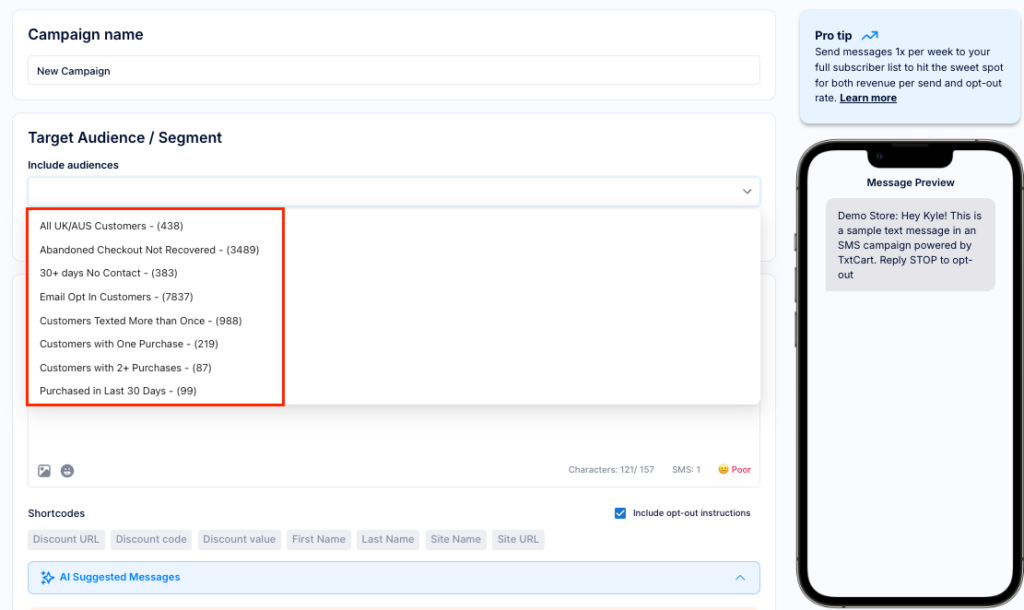
Optimizing Campaign Performance
Marketing campaigns need constant monitoring and adjustment. AI continuously analyzes performance data to automatically optimize your marketing efforts for better results.
AI helps optimize performance by:
- Automatically running A/B tests on different ad creatives, headlines, or calls to action.
- Adjusting bid strategies in real-time based on campaign performance against goals.
- Reallocating budget towards the highest-performing marketing campaigns and products.
- Identifying underperforming customer segments or products to refine your strategy.
Tools to make that happen:
- heatmapAI: If your CRO strategy is based on clicks and scrolls alone, you’re optimizing for tire kickers. heatmapAI flips that. It’s the only on-site analytics tool that ties revenue to every pixel of your site. You don’t just see what visitors do — you see what buyers do.
- Google Performance Max (with AI): For paid campaigns, Performance Max uses AI to automate asset testing, audience targeting, and budget allocation across Google Search, YouTube, Gmail, and Display.
- Rebuy: A smart personalization tool that plugs into Shopify. Rebuy uses AI to optimize product recommendations, bundles, and upsell flows based on real-time customer data.
AI for Pricing Optimization
Setting the right price isn’t just about covering costs; it’s about maximizing profit margins and staying competitive. AI brings sophistication to pricing strategies, allowing for dynamic adjustments based on market conditions and customer behavior.
Implementing Dynamic Pricing
Market prices fluctuate. Competitors change their offers. AI pricing tools monitor these changes in real-time and automatically adjust your product prices to stay competitive while protecting your desired profit margin.
AI tools enable dynamic pricing by:
- Continuously monitoring competitor prices across multiple online stores.
- Automatically adjusting your prices based on predefined rules (e.g., always be $0.50 lower than the lowest competitor).
- Implementing time-sensitive pricing adjustments for flash sales or during periods of high market demand.
- Testing different price points to determine which converts best while maintaining profitability.
AI Tools to Perfectly Implement Dynamic Pricing:
- Prisync – Tracks competitor pricing and stock, automates repricing based on custom rules
- Wiser – Offers dynamic pricing and MAP (Minimum Advertised Price) monitoring
- BlackCurve – Optimizes pricing using machine learning and demand forecasting
Analyzing Price Elasticity
How sensitive are your customers to price changes for a specific product? AI can analyze past sales data and customer behavior to understand price elasticity, helping you determine when you can raise prices or when you need to offer discounts.
AI helps determine price elasticity by:
- Identifying products where a small price change significantly impacts sales volume.
- Finding products where customers are less sensitive to price, potentially allowing for higher pricing.
- Optimizing bundle pricing for complementary products based on how customers purchase them together.
Recommended AI Tools to Analyze Price Elasticity:
- Intelligems – Offers pricing experiments and elasticity testing for Shopify stores
- Omnia Retail – Combines pricing elasticity data with competitor intel for smarter strategies
- Pricefx – Enterprise-level price modeling and elasticity tracking using historic and real-time data
Applying Psychological Pricing
Certain pricing techniques are known to influence customer perception and behavior. AI can help you test and implement these psychological pricing strategies to improve conversion rates.
AI can help test and implement:
- Charm pricing (ending prices in .99 or .97).
- Prestige pricing for higher-end products signals quality.
- Decoy pricing, introducing a less attractive option to make another seem more appealing.
TxtCart offers robust A/B testing within your SMS marketing campaigns. This allows you to test different pricing-related elements, such as varying discount levels or free shipping thresholds offered in abandoned cart messages or promotional texts, to pinpoint which approach yields the highest conversion rates and maximizes revenue for your dropshipping store through direct customer engagement.
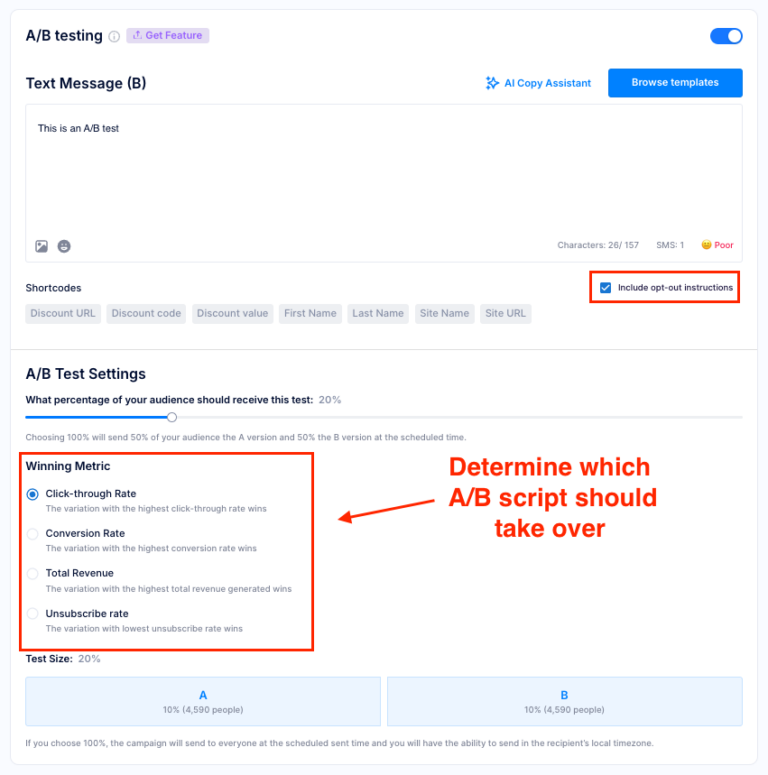
AI for Inventory Management (Virtual)
Even without physical stock, managing your relationship with dropshipping suppliers and preventing overselling is crucial. AI provides the visibility and forecasting power needed to manage virtual inventory effectively and ensure smooth order fulfillment.
Accurate Demand Forecasting
Predicting how many units of a product you’ll need from your suppliers is key to avoiding stockouts or disappointed customers. AI technology analyzes various data points to provide accurate demand forecasts.
AI tools predict future demand based on:
- Analysis of historical sales data, accounting for seasonality and past promotions.
- Monitoring of current market trends and external factors that might influence demand.
- Considering the impact of upcoming marketing campaigns and planned sales events.
- Even monitoring competitor stock levels to anticipate potential shifts in customer traffic.
AI tools for precise demand forecasting:
- Inventory Planner – Inventory Planner connects to your store and analyzes sales velocity, seasonality, and product trends to create precise demand forecasts. It even recommends how much to reorder and when, so you don’t tie up money in dead stock.
- Netstock – Netstock combines AI and machine learning to spot sales patterns, identify stock risks, and forecast demand across multiple channels. It’s ideal for stores that manage large product catalogs and need to avoid stockouts or over-ordering.
- Stocky (by Shopify) – Stocky is built directly into Shopify and uses historical sales data to suggest restock quantities. It also accounts for lead times and vendor performance, helping you reorder more efficiently and avoid disruptions.
Real-Time Stock Level Monitoring
Staying updated on your dropshipping suppliers’ inventory levels is critical. AI can connect to supplier feeds to monitor stock in real-time and take action when levels are low.
AI can automatically:
- Track supplier inventory levels in real-time to prevent you from selling products that are out of stock.
- Generate automated alerts when a product is running low at a primary supplier.
- Suggest or automatically switch to alternative dropshipping suppliers if the primary stock is depleted.
- Temporarily hide products from your dropshipping site when they are unavailable from all connected suppliers.
Top real-time stock level monitoring tools:
- Spocket – Spocket integrates with U.S. and EU-based suppliers, syncing real-time inventory data to your dropshipping store. If a supplier’s stock changes, your listings adjust instantly, preventing overselling.
- Syncee – Syncee connects your store to a network of global suppliers and keeps product data updated in real time. It automatically updates prices and stock levels, and can pause products that are no longer available.
- DSM Tool – DSM Tool is built for marketplaces like eBay and Facebook Marketplace, but also works for Shopify. It constantly monitors your supplier’s inventory and pricing, and updates your listings automatically when changes occur.
Streamlined Order Processing
Getting orders from your customer to the correct supplier quickly and accurately is essential. AI automates and optimizes the order fulfillment process.
AI streamlines order fulfillment by:
- Automatically routing orders to the most appropriate dropshipping supplier based on factors like stock levels, location, and pricing.
- Integrating with shipping carriers to automatically track shipping status and provide timely updates to customers.
- Identifying potential fulfillment issues early, such as address errors or supplier delays.
- Automating aspects of returns and exchanges processing based on predefined rules.
Best AI tools for order processing:
- AutoDS – AutoDS handles everything from order placement to tracking updates. Once a customer orders, AutoDS automatically routes the order to your chosen supplier, updates shipping info, and even handles returns if you enable that feature.
- Orderhive – Orderhive gives you a centralized dashboard to manage orders from multiple stores and suppliers. It automates fulfillment workflows, sends tracking info to customers, and even detects problems like delivery delays or address mismatches.
- Shopify Flow – Shopify Flow lets you create automations to handle repetitive tasks—like routing orders based on supplier stock or tagging orders that need manual review. It’s a powerful tool for scaling stores using dropshipping or multiple suppliers.
AI for Customer Service
Providing excellent customer service is essential for building a trusted brand and encouraging repeat business. AI enables you to offer fast, personalized, and efficient support at scale, boosting customer satisfaction.
Leveraging AI Chatbots
Many customer inquiries are repetitive. AI chatbots can handle a large volume of common questions instantly, providing 24/7 support without human intervention.
Modern AI chatbots can:
- Answer frequently asked questions about product details, shipping times, and return policies.
- Guide customers through the purchase process, including navigating the site and applying discounts.
- Help troubleshoot minor issues related to orders or products.
- Collect valuable customer feedback and identify common issues needing attention.
Looking to transform your customer communication? TxtCart’s AI-powered SMS platform not only handles abandoned carts but also delivers real-time, personalized support 24/7—all while being 32x cheaper than human agents. This means you can boost customer trust and satisfaction, increase conversions, and dramatically reduce support expenses.
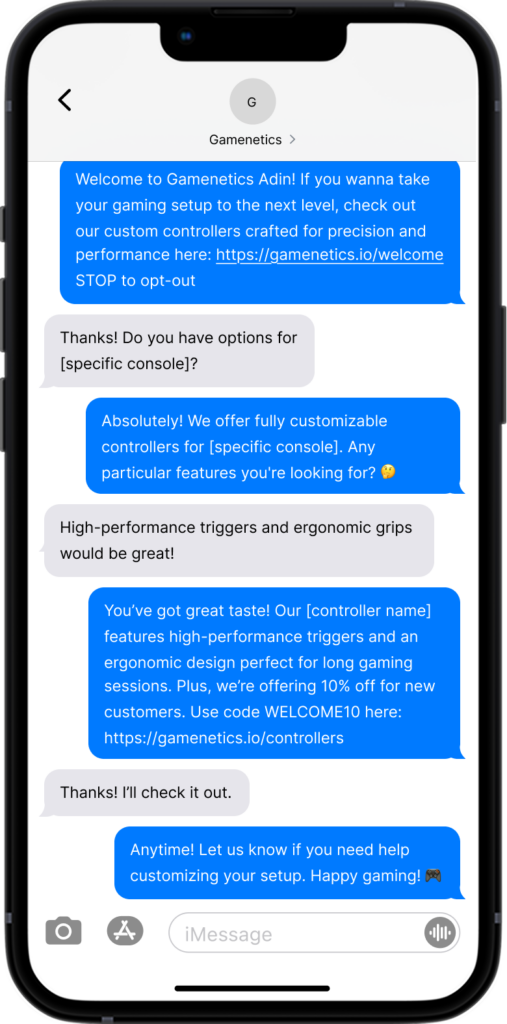
Some other recommended AI chatbots:
- Tidio – Tidio combines live chat and AI-powered bots to automate customer support across your site, Facebook Messenger, and Instagram.
- Heyday by Hootsuite – Heyday is built for ecommerce and connects directly with your product catalog.
Delivering Personalized Recommendations
Showing customers products they’re likely to buy increases conversions and average order value. AI analyzes customer behavior to provide highly personalized product recommendations.
AI enhances the customer experience with:
- Personalized product recommendations based on their browsing history, past purchases, and items in their cart.
- Suggestions for complementary products during the checkout process.
- Tailored follow-up offers or content after a purchase is made.
- Automated re-engagement campaigns for customers who haven’t visited or purchased recently.
TxtCart’s intelligent conversational AI facilitates two-way communication via SMS, enabling it to understand and respond to individual customer inquiries in real-time. This personalized dialogue helps address specific questions or concerns a customer might have. As a result, it provides timely support that can guide them toward completing a purchase and enhancing their overall experience with your dropshipping brand.

Use these AI tools for personalized recommendations:
- LimeSpot – LimeSpot uses real-time customer behavior and purchase history to recommend products across your homepage, product pages, and checkout. It also personalizes upsell offers to increase cart value.
- Nosto – Nosto tracks user behavior and uses that data to create personalized shopping experiences. It powers product recommendations, pop-ups, and even dynamic content blocks based on user segments.
- Clerk.io – Clerk.io provides AI-driven product recommendations, search, and email content based on what customers are browsing and buying. It’s known for its fast onboarding and compatibility with many ecommerce platforms.
Analyzing Customer Feedback
Understanding what your customers think is vital for improvement. AI tools can analyze large volumes of customer reviews, survey responses, and chatbot interactions to extract valuable insights.
AI tools analyze customer feedback to:
- Identify common pain points or issues with specific products or your overall service.
- Detect shifts in customer sentiment over time.
- Highlight opportunities for product page improvements or adding new products.
- Identify and potentially flag loyal or influential customers.
Use these AI tools to efficiently analyze customer feedback data:
- MonkeyLearn –MonkeyLearn uses natural language processing to automatically tag and sort customer feedback by topic, sentiment, and urgency.
- Qualtrics XM Discover – XM Discover can sift through text data across multiple sources—like support chat logs, social media, and surveys—to surface pain points and satisfaction drivers.
- Chattermill – Chattermill unifies customer feedback from reviews, surveys, support tickets, and more into one AI-driven dashboard.
How to Implement AI in Your Shopify Dropshipping Store
Integrating AI into your dropshipping business might sound complex, especially if you’re running a Shopify store. But by following a structured approach, you can successfully leverage artificial intelligence without getting overwhelmed.
Step 1: Assess Your Needs
Before you start looking at specific AI tools, take a hard look at your current operations. Where are the bottlenecks? Which tasks consume the most time? What data could you be using better?
- Identify the areas where you spend the most time on manual tasks.
- Pinpoint processes prone to human error.
- Determine what crucial customer data or market data you’re not currently leveraging for decisions.
Step 2: Start with One Area
Don’t try to revolutionize your entire dropshipping business overnight. Pick one high-impact area to begin your AI implementation journey. This allows you to learn and adapt without disrupting everything.
- If finding profitable products is a constant struggle, start with an AI product research tool.
- If customer inquiries are overwhelming your time, implement an AI chatbot.
- If you’re leaving money on the table with suboptimal pricing, explore an AI pricing tool.
Step 3: Integrate with Shopify
Most AI tools designed for eCommerce offer straightforward integrations with a dropshipping website builder like Shopify. This is crucial for seamless data flow and automation.
- Look for tools available directly on the Shopify App Store or those that offer easy API connections.
- Follow the tool’s instructions to connect it securely to your Shopify store data.
- Configure the tool’s settings based on the specific business rules you established in Step 1.
Step 4: Train and Optimize
AI learns from data and your interactions. After implementation, actively monitor the tool’s performance and provide feedback to help it improve.
- Review the AI’s recommendations and output regularly. Provide corrections or feedback to refine its learning.
- Track key performance metrics related to the area where you implemented AI (e.g., conversion rates, time spent on customer service, accuracy of forecasts).
- Gradually adjust the tool’s settings and parameters as you gain confidence and see what works best for your specific products and target audience.
Step 5: Expand to Other Areas
Once you’ve successfully integrated and optimized AI in one area and seen positive results, you can strategically expand to others. Build on your initial success.
- Use the knowledge and experience gained from your first implementation to inform your approach to subsequent AI tools.
- Look for AI tools that can integrate with each other, creating a more connected and automated ecosystem for your business.
- Gradually build a comprehensive AI stack that covers more and more aspects of your drop shipping operation.
Read Next: Best Dropshipping Apps for Shopify
Common Challenges Dropshippers Face When Using AI (+ How to Fix Them)
Adopting new technology isn’t always smooth sailing. Here are some common hurdles dropshippers face when implementing AI and practical ways to overcome them.
| Challenge | Solution |
|---|---|
| Cost of AI Tools | Many AI dropshipping tools offer free trials or affordable starting plans. Kick off with these to test the waters and confirm you see solid returns before paying for pricier options. Focus on tools that clearly show ROI as you grow. |
| Data Privacy Concerns | Pick AI providers who are upfront about how they handle data and follow privacy rules like GDPR or CCPA. Be transparent with your customers too about data usage, and keep your own site’s security locked down. |
| Over-Reliance on Automation | AI is your assistant, not your boss. It doesn’t replace smart human oversight. Always review AI suggestions and automated tasks. Be ready to step in and make the final call, especially for things like customer replies or pricing. |
| Integration Issues | Look for AI tools designed to integrate smoothly with your dropshipping platform (like Shopify). Read reviews and check their guides on how easy the setup is. If things get tricky, bringing in a developer might be worth it. |
| Learning Curve | Reputable AI tool companies usually offer helpful tutorials, guides, and support. Start with tools known for being user-friendly. Don’t stress the learning process; mastering the platform pays off big time down the road. |
The Future of AI in Dropshipping
Artificial intelligence isn’t standing still, and its role in dropshipping will only become more sophisticated. Staying aware of emerging trends can help you plan for the future of your automated dropshipping store.
Here’s a glimpse into what’s next:
- Predictive Analytics: Expect AI to get even better at forecasting, not just analyzing past data but accurately predicting future market shifts, customer preferences, and even potential supply chain disruptions. This will allow dropshippers to be proactive, not just reactive.
- Voice Commerce Integration: As more customers use voice assistants for shopping, AI will be crucial for optimizing product listings and store navigation for voice search, creating seamless voice-friendly shopping experiences.
- Visual Search Capabilities: AI-powered visual search will allow customers to find products by simply uploading an image, opening up new avenues for product discovery and making it easier for customers to find exactly what they want on your dropshipping websites.
- Autonomous Dropshipping: While full automation is still some way off, advanced AI may handle more aspects of the business with minimal human input, potentially managing everything from identifying trending products to handling order fulfillment and customer service inquiries automatically.
- Ethical AI and Transparency: As AI becomes more integrated into online businesses, there will be increased focus on ethical considerations, ensuring fairness, avoiding bias, and providing transparency in how AI makes decisions that affect customers.
Read Next: Best Shopify AI Tools for eCommerce
Ready to Automate Your Dropshipping Business with TxtCart?
You’ve seen how artificial intelligence is no longer optional, but a powerful lever for dropshippers aiming for efficiency and growth. By strategically implementing AI for product research, pricing, marketing, and customer service, you build a more robust, data-driven, and profitable online store.
We covered how AI can:
- Uncover winning products hidden in vast market data.
- Automatically adjust prices for maximum profit and competitiveness.
- Create personalized marketing campaigns that resonate with your audience.
- Provide instant, intelligent customer support around the clock.
As you implement AI to automate and optimize various aspects of your dropshipping operations, consider the significant impact AI can have on customer interactions and revenue recovery. Ready to see how TxtCart’s AI can boost your abandoned cart recovery and revenue? Integrating this powerful capability is a straightforward step to strengthen your overall AI marketing strategy.
Want to try conversational SMS for free?
Drive more sales with intelligent AI-driven automations that recover carts, engage customers, and streamline flows — saving you 32x in costs. No contracts or minimums.
- Try free for 14 days
- 10x ROI guaranteed
- Join 3000+ Shopify brands
